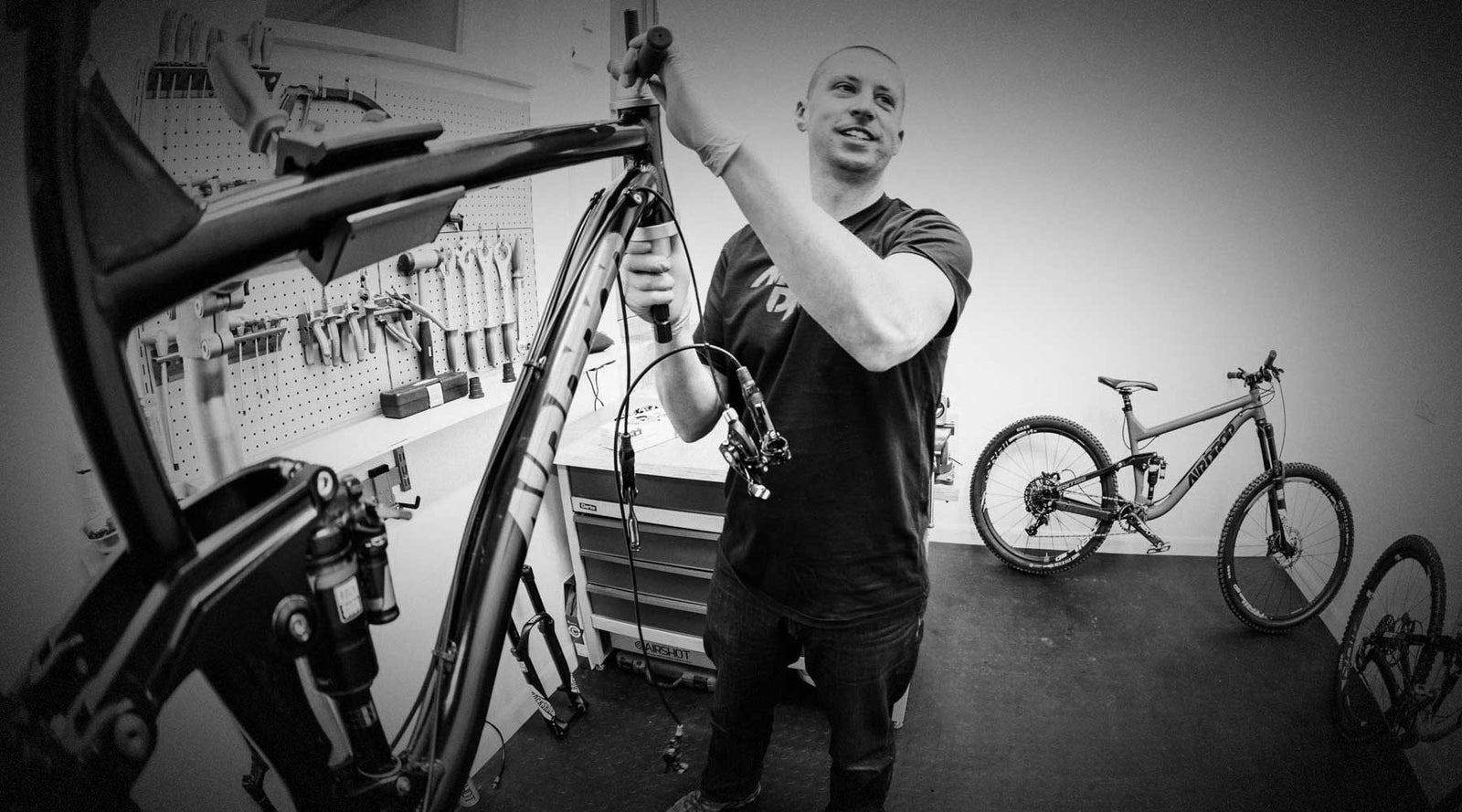
Shovel & Pick Interview
September 14, 2016
Founded in 2016, Shovel & Pick MTB has simple intentions, to provide an alternative perspective on Mountain Bike media. With an emphasis on original content along with curation of the best the web has to offer, S&P aims to inspire and promote conversation about Mountain Biking. This is a transcript of an interview given with Shovel & Pick in September 2016.
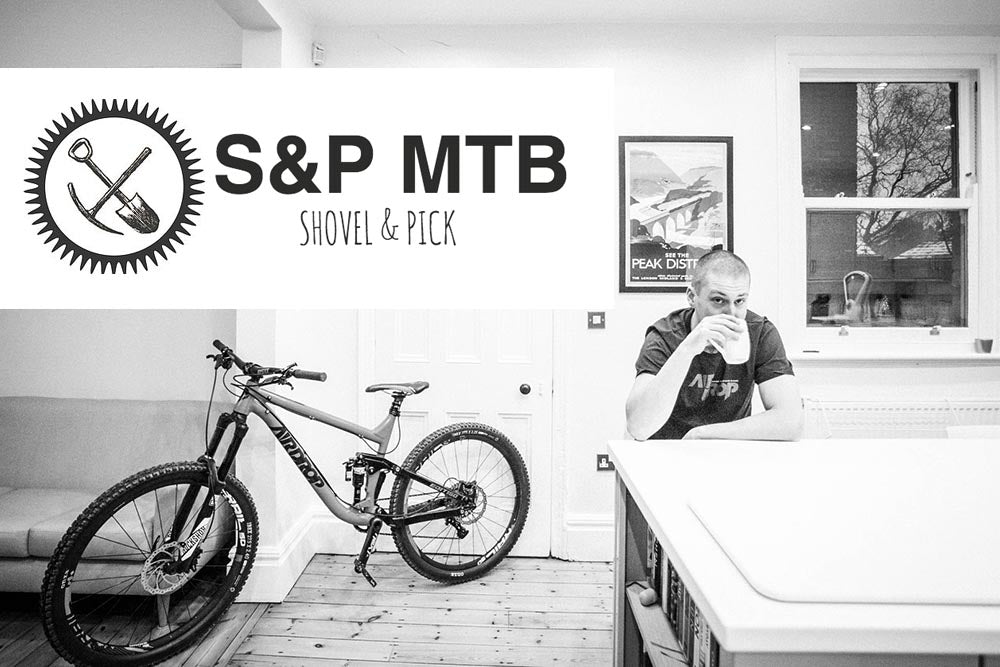
Your background is in graphic design and marketing. What motivated you to start a bike company with no prior experience of bicycle manufacturing and little industry experience?
I wanted to be a designer in the outdoor industry, and that’s why I came to Sheffield in the first place. I hated the idea of working for someone else, but I figured if I was doing creative work, and I was around product that I was into, it would be bearable. Eventually I scored a job as a web designer for an outdoors company, and that led into graphic design and design management. I did that for 10 years and loved it before moving onto a bike company for a couple of years.
It was never the plan to work in marketing as such, but that’s the context for most design jobs. For me it was always about the creative work. I never got tired of designing stuff, and it’s still really important to me. But I sure got tired of the marketing. Too much of it was cynical, very commercial and hard-sell. Occasionally there was a nice project but too often it was promoting things I didn’t believe in, or products I knew were not up to scratch.
Originally I wanted to set up a design agency. It was the logical progression from being a designer to setting up shop on my own. But I realized that I would still have the same frustrations: I would still be working for other people, I wouldn’t have creative control, and often I’d be marketing something I didn’t believe in. That seemed too empty; I wanted to do something that I could really believe in, something with substance and a bit of integrity. That way the work would always be honest.
The bike company I was working for had the right business idea, but it was awful; there was a really bad culture and everyone was miserable. That was reflected in the products and the service, and the customers could see it. I was working hard, long hours, for a person I didn’t respect and it was making me unhappy. I felt that it was now or never. So I sacked off my day job and started to make a plan. I came to the conclusion that setting up my own bike company was a sound idea, that it would be extremely difficult but not impossible. I became obsessed with the challenge and even though there were a thousand ways to screw it up, the prize was too good to give up: imagine having your own bike company. I had to try.
It takes a certain mindset to truly make a vision a reality and to turn your back on an established career. What was the deciding factor that made you pull the trigger and commit to starting the company?
For a while I worked at a great company in the outdoor industry, and I really believed in what we were doing. I was working with good people, with good products. That kept me in the same place for a long time; it was hard to leave. But eventually I had to leave for my own progression. So I took a big step up and moved to the bike industry and at first it was good, but the whole thing was built on sand and it went badly wrong. The values of that business were so far removed from my own values that it was not a place I wanted to stay.
It’s easy to over-state the gravity of leaving a job. I was lucky enough to have a lot of experience and a bit of skill. So it didn’t feel like an irrevocable step; if it didn’t work out, I would just get another job, and it could hardly have been worse than the one I left. That way of looking at it meant that I didn’t feel that I was taking a huge risk.
The company has taken twelve years of saving to come to fruition. What kept you motivated to save money during these years, without a clear vision of what it was that you were aspiring to create?
The only way I could rationalize going to work for someone else every day was to tell myself it wasn’t forever. One day I’d be doing my own thing. So I saved a bit of money every month towards that goal. I just set up a standing order and the money went out. I never had it, so I didn’t miss it. Yes there were hard times and plenty of opportunities to spend it on other things, but that money was about my independence, my future and my whole way of life.
Maybe I didn’t know exactly what the company would be, but I knew what it would be like. It was always going to be about quality and creativity. And it would be a great place to work – not about achieving some goal in the future, it would be about enjoying each day. That’s the kind of place I wanted to work and if nobody else could offer that to me, I would have to make it happen myself.
Was there any point during the process where you questioned whether Airdrop could become a reality?
In some ways yes, you question it every day and I think it’s healthy to do that. Especially when you’re working on your own, you need to stay grounded and question everything. By doing that you increase your confidence that you’re making good decisions and moving in the right direction. But at the same time you have to have a belief that it will happen, no-matter what, to stay motivated through the hard times. When something goes wrong – and that’s happened plenty of times – you’re faced with a simple choice. Am I going to give up, or carry on? When you think of it like that, the answer’s obvious. You carry on.
Were there any companies that you looked to for inspiration when you were starting this process, within biking or otherwise?
I’ve always been inspired by brands with a really clear focus and identity. The creative work coming out of board sports for example has always been a big source of inspiration. Look at the photography in surf & snowboard, or the film coming out of skate brands. It’s incredible and has been for a long time. I want Airdrop to inspire other people, not just coerce them into buying stuff based on price or batter them with features & benefits.
I’ve also taken something from the ethos that you get at the best design companies. They’re never there for the sake of making money and chasing growth. It’s always about producing great creative work, and they understand that you have to create an environment where people are happy to work. That’s when you get the best out of people and you can produce something great.
I have admiration for any company that’s willing to stick two fingers up to the conventions, do something a bit different and make it stick. They’re the ones who affect change.
You’ve spoken about how your first choice manufacturer pulled the plug on you, but in many ways this was constructive moving forward. Do you think that in some way success requires an element of failure, to prove to yourself that you truly believe in what you’re creating regardless of the obstacles?
I think it’s too easy to see success and failure as polar opposites. It’s not that black & white. Put it this way: unless you fail utterly, you are succeeding every day. You have to derive satisfaction from all the small successes and not fixate on some big target. Likewise you can’t be knocked back by the small failures. Everything is a learning experience if you have the right mindset. You’re going to make loads of mistakes and that’s cool... Just don’t beat yourself up about it and try not to make the same mistake twice.
There are loads of things I want to do with Airdrop, and I can’t do most of them because I don’t have the money or the time. But it’s not a case of thinking “I can’t do that”; it’s more a case of “I’m not doing that yet… but I will do it in the future”.
How important do you think your previous career experience has been to your success in establishing Airdrop? If money weren’t an obstacle could you have created this brand straight out of university?
No way could I have done this at age 21. I just wasn’t mature or experienced enough to do it. Work taught me - or enabled me to learn - a lot of skills and that has helped. I also had to work through a lot of things that I didn’t agree with or would have done differently myself. That was all part of understanding what kind of company I wanted Airdrop to be.
But it’s not just about career experience, it’s also about life experience. I was idealistic and that hasn’t changed, but I’ve learned an awful lot about the real world. It took me a long time to really understand what I wanted from life and to be confident enough in myself to step out of the mainstream and try to make it happen.
The money thing is almost irrelevant. Airdrop might have cost me my life savings, but it was a lot less than you probably think. If you set your mind to something - dedicate yourself to it - you can make it happen. The money was just one of the obstacles to be overcome, and probably not the biggest.
What was the thought process behind choosing to enter the market with an enduro frame, rather than say a hardtail that might have been easier to design and manufacture?
Maybe it would have been more sensible to start with a hardtail. Definitely it would have been easier. But taking the easy option is rarely the most rewarding. If you always go with easy, you’ll never achieve anything. For a start, there are several small brands out there producing really good hardtails already, some quite close to home. I didn’t want to compete with them – I wanted to take on the big boys. If a thing’s worth doing, it’s worth doing well. So I wanted to tackle it head-on.
I also felt that a lot of bikes had become too complex and too expensive, and I wanted to do something a bit different. A lot of emphasis was being placed on features and performance, but it seemed to me that a lot of bikes were being designed to sell, not being designed to ride. So they look great in the magazine, they have plenty of clever little features, and they’re all apparently faster than the other brand’s bike. But what are they really like to ride every week and to live with for a few years? What happens when they’re covered in shit, the bearings are gone and you need to rebuild it?
Can you explain how the partnership with clayspades came about?
I always wanted Airdrop to enable me to get involved in some cool stuff and produce some quality content. I never wanted to advertise the brand or the bikes as such; I just wanted to produce content that would inspire people and get them stoked to ride. I’ve always felt that a lot of brands try too hard to sell their products, and it’s obvious in the content they put out. For me, the best brands are confident enough to let their products speak for themselves, and let people come to them.
The plan was always to make videos, so I was working with Gee Milner and Sam Taylor and throwing around some ideas. They’re young and super talented. I’m old and a bit more experienced, so it’s a good partnership. The obvious place to start was Wharncliffe, and we felt that it had been done to death, but nobody has produced something with real quality there. I think Gee and Sam just needed a client willing to trust them to make the film that they wanted to make. So we offered the Clayspades crew the bikes to ride, and they jumped at the chance. Everyone was stoked on the idea and I think you can see that in the final edit.
In many ways the Clayspades edit was an inspired piece of marketing. Did you anticipate how positive a reaction it would have?
We knew that we had a good idea for sure, and a good group of people working on it. Max, James and Rob are the real deal, so all we had to do was produce a film that could capture how rad their riding is. Everyone wanted something quality, so we worked hard to keep the standard high. But we also put a lot of emphasis on not taking it too seriously, and not pressurizing the whole project.
The reaction we got was pretty much exactly what we wanted. We hoped it would go this well, but didn’t expect it. There’s a big difference between knowing a thing is possible, and making it happen. For me this is only the beginning; Clayspades was good but we’ve got loads of other ideas and we want to keep making stuff that gets people stoked to ride.
What do you think it is that will separate Airdrop from its competition and make it a success?
I want Airdrop to be the best brand, not the biggest. I want to stay focused on delivering great bikes and inspiring people to ride. If I keep my feet on the ground and make sure I look after my customers, it’ll work.
I think your background in design is evident in the Edit. How important to you think image and aesthetics are to a bike and to a brand overall?
It’s hard to say that image is important without sounding superficial, but let’s be honest: it is important. It’s not about showing off; that’s not cool. But you want a bike that looks fast and fun to ride. You need to ‘get it’ straight away: I want people to understand the bike as soon as they see it.
I want people to be proud of riding an Airdrop bike, and that’s about more than aesthetics. It’s about having values that people identify with; it’s about being honest, inspiring people and making a connection. Airdrop is about quality, creativity and simplicity. I want the bikes to represent those values and I hope those are things that will appeal to people.
With a direct distribution model enabling competitive pricing and the Internet offering an almost limitless platform for marketing, do you think we’ll see the rise of more independent bike companies?
Yes, there will be more independent companies, and you can see that happening already. It’s great to see the resurgence of artisan frame builders and other indie bike brands popping up. The bigger the big brands get, the more own-brands the retailers and distributors produce, the more people will need the independents. Someone’s got to keep the big brands honest.
In some ways the barriers to entry are lower than they ever have been before. The kind of people who might have started up a bike shop in the past are now looking at their own bike brand. Airdrop sometimes gets categorized with the likes of Canyon and YT Industries just because our store-front is a website, but the reality is that Airdrop has much more in common with a bike shop. Every bike I’ve sold so far has been by working individually with the customer. There’s no venture-capital backing and it’s not commercially driven.
The direct model is advantageous, for now. But once the industry has adjusted, it won’t be a big help. And in any case it is only a price advantage, which is important but not everything. Being cheaper is a short-term game. After that’s worn off, you need to have a strong brand that people understand, great bikes and quality service.
Speaking more generally, this process must have given you some unique insight into the mountain biking industry and how it operates, is there anything that you’d like to see change?
I have a limited experience of the industry, and I certainly wouldn’t call myself an expert. It seems to me that it’s a challenging time for the (mountain) bike industry, a period of growth and change. There are obvious themes that we all see: bike shops being squeezed, e-commerce on the rise, German brands flexing their muscles. They’re in the media because they create winners and losers. But behind all that we have a relatively young sport that’s just coming out of adolescence and trying to grow up. There are bound to be growing pains. And what will emerge is a different industry to the one we grew up with. Trying to hold back the tides of change is a fool’s game.
I’m not here to tell the rest of the industry what to do. That’s out of my control. What I can control is the way Airdrop operates, and maybe if I do it right I can set a good example. So my focus is to prove that quality bikes and good service trump cheapness in the long run.
How satisfying was it when the first batch of frames were delivered?
The big day was the day we went into production, and that was back in October. It was then that I had to commit to the design, to finally say “that’s it, no more changes”. And hand over the money. So since then it’s been a question of waiting, staying patient and trying not to worry about it too much. When the frames finally arrived the dominant feeling was actually one of relief. They hadn’t sunk in the ocean, been seized by pirates or welded back-to-front. They were exactly as specified and the finish was better than I had hoped.
What followed was a frantic week of building up and shipping the pre-orders out to customers. Those guys had showed real faith in me and the bike, and I didn’t want to let them down. I was super nervous on delivery day. By the weekend I started to see people’s pictures on Instagram and I could see that they were stoked, so it was only then that I felt a sense of satisfaction.
How have things changed in the months since the Edit went on sale?
Although I was confident that the Edit is a good bike, I honestly didn’t know what kind of reception it would get, or whether people would be into the whole idea of Airdrop Bikes. Looking back, that moment when the first batch of frames arrived was a real milestone. Straight away my whole mindset changed from trying to make something happen to it’s actually happening. I got a good bit of coverage early on, I guess just because Airdrop was new, and people started to like what was happening on social media. So I started to get interest and the first few sold. Suddenly I had customers to look after, bikes to build, stock to buy. It became a completely different game. And of course it was a steep learning curve.
I think it took a few weeks to really find my feet and get myself set up with good processes, good working practices that enabled me to get everything done to the right quality level. Then as the Summer kicked in, sales really took off and it was all I could do to get the ‘day job’ done. I had to sacrifice some of the development work I was trying to do - future bikes and so on - because looking after customers has to be the main priority. But at the same time there’s no future for Airdrop if I don’t make it happen, so now my focus is on finding the right help to make sure I’m able to push the whole thing forward whist at the same time making sure that customers are being looked after properly. I suppose that this is the game when you’re trying to build something from scratch.
What are your aspirations for Airdrop, how do you envision the company growing moving forward?
I have big ambitions for Airdrop, but none of them can be expressed in numbers. All I want to get out of it for myself is to earn a living, to keep challenging myself and to make bikes that I’m proud of. I think if you focus on the commercial side of things too hard, you’re not focusing on quality or looking after your customers. The way I see it, if you produce great bikes and look after people, success will come naturally. There’s no need to force it.
Airdrop will stay small for as long as possible, and remain focused on the gravity side of the sport. I can’t see a time when we’re producing dozens of bikes, trying to chase every type of customer. You’ve only got a certain capacity, and you can spend it on the breadth of the depth of your offer. I would much rather focus on producing a small number of awesome bikes than a large number of average bikes. So there will be maybe 3-5 bikes in the range, maximum. They’ll be good though. Very good.
There is another bike in the pipeline, and you’ll see that later this year. After that I’m not saying, but I’ve got a plan. It is probably not what people are expecting, but that’s the best bit about setting up your own company: you can take it wherever you want.
Interview conducted by James Good on behalf of Shovel & Pick MTB, September 2016. You can see the original feature over on the S&P Website.
Ed Brazier
Ed is the owner of Airdrop Bikes. A former web and graphic designer, he sacked off his job one day and decided to start up a bike brand.
Leave a comment
Comments will be approved before showing up.
Also in Airdrop Bikes Blog
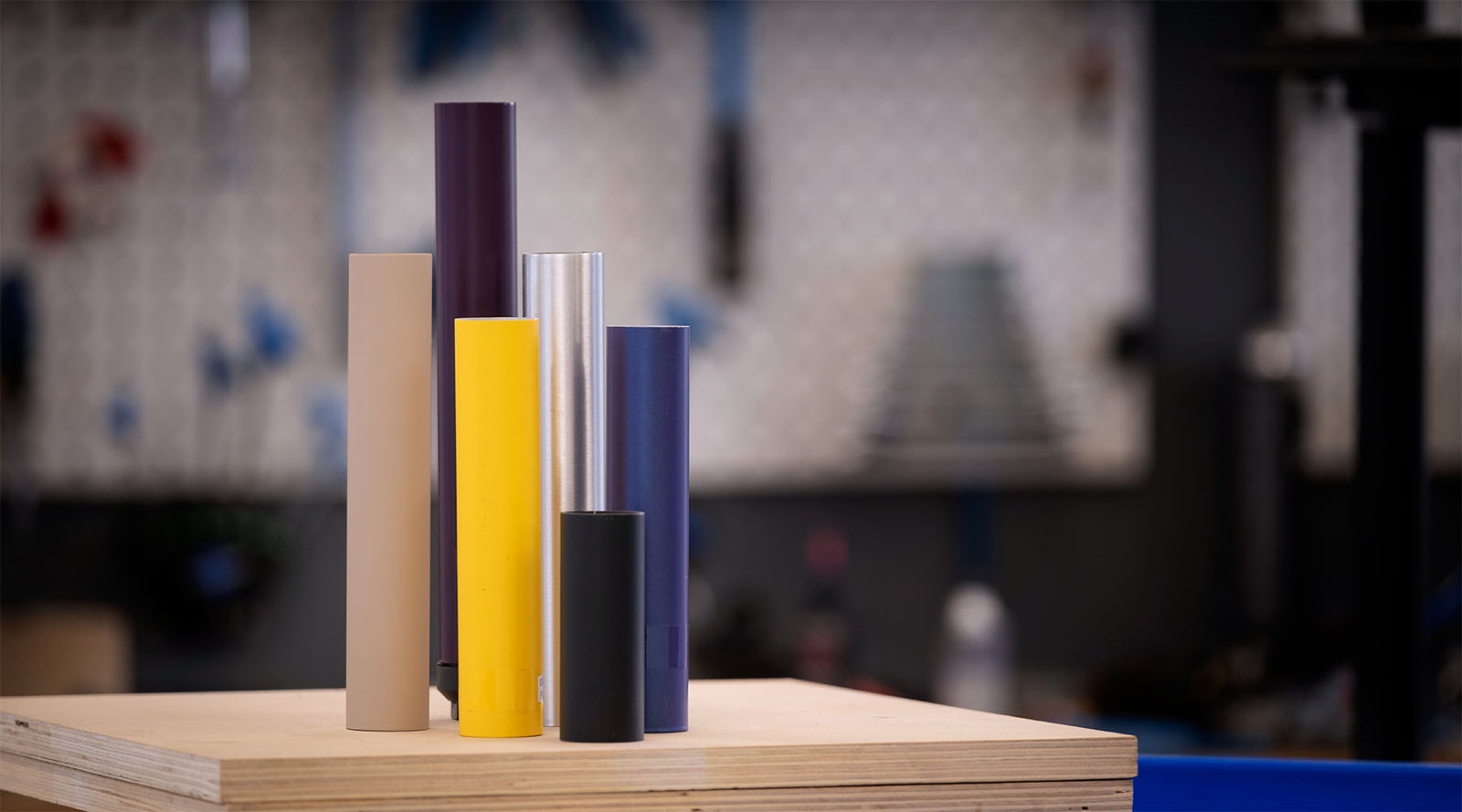
New Frame Colours
February 18, 2025
With new batches of Edits and Slackers coming in (Fades just arrived), we've taken the opportunity to freshen things up with new colours.
Read More
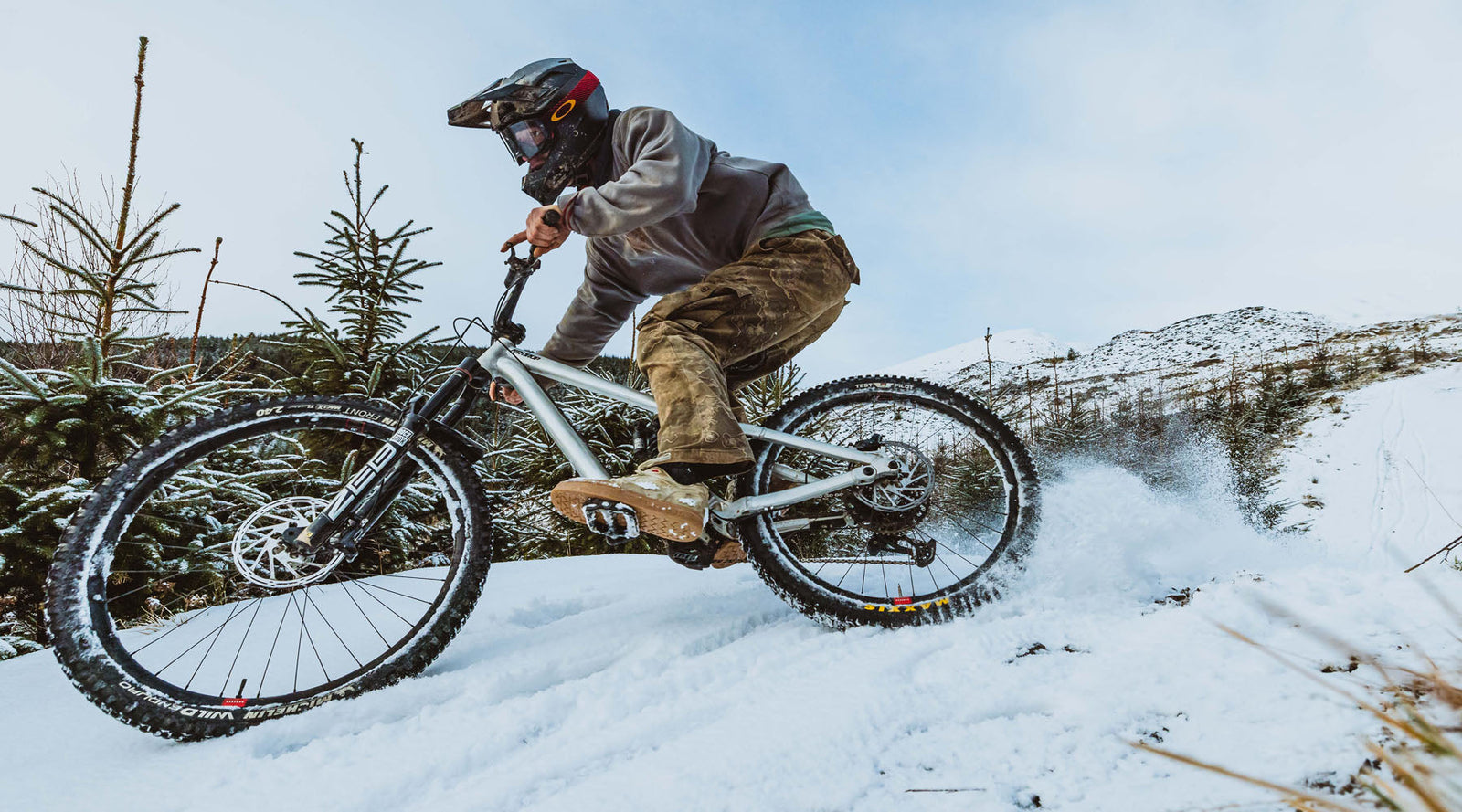
Introducing Alf Raynor
February 12, 2025
We're stoked to announce that Alf Raynor is riding for Airdrop Bikes. Alf is likely the hardest man in MTB, he loves the Graft and goes hard on the build. His Raw style on the bike and commitment is something that has to be seen to believed; it's wild.
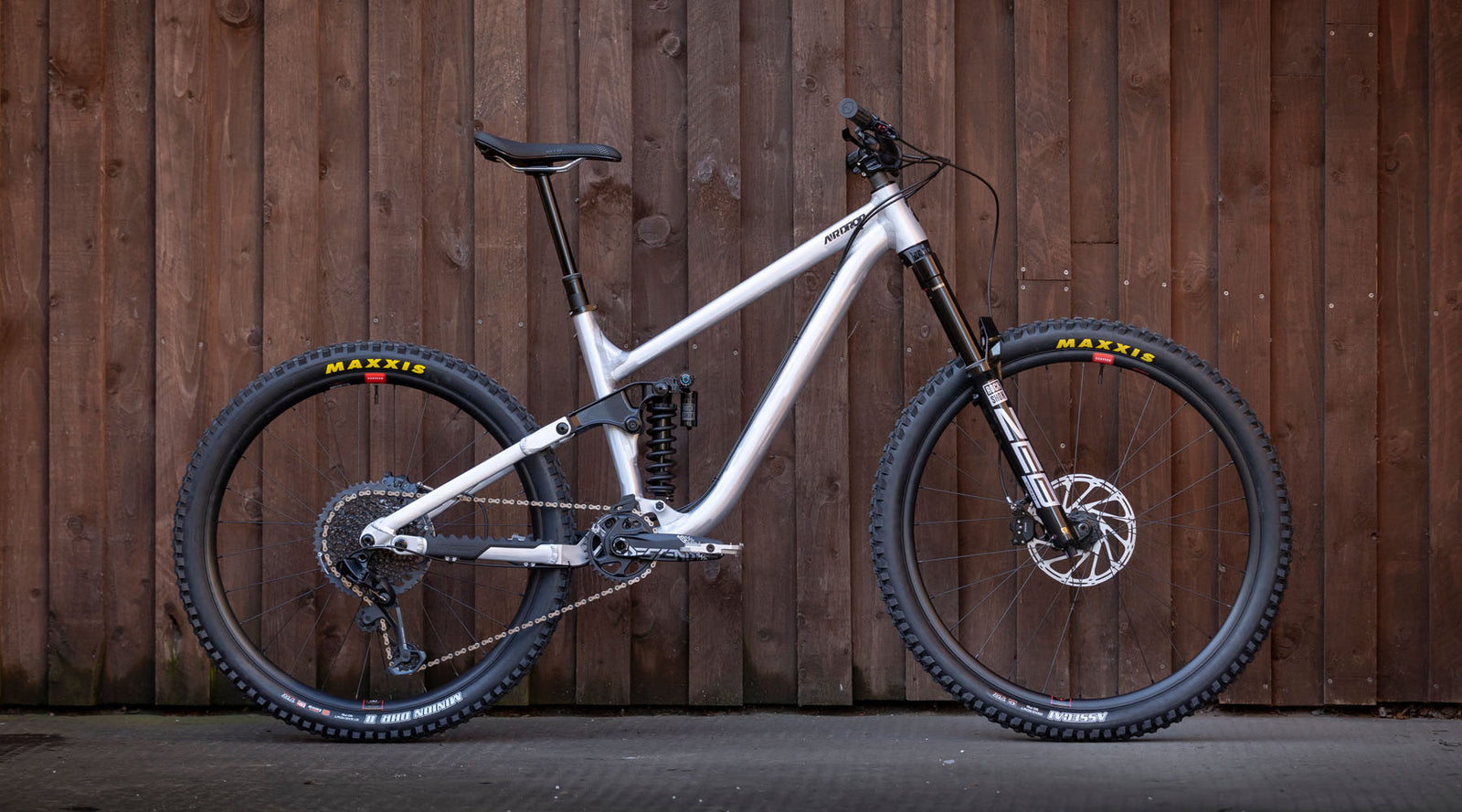
New Batch of Edits Incoming
February 07, 2025
The new batch of Edit frames is complete and is on it's way to Sheffield. We've taken the opportunity to freshen things up with all-new build options and colours, and preorders are now open.
Email Newsletter
Our monthly email newsletter gets you access to all the good stuff before everyone else.
Get The Inside Line
We're always working on stuff behind the scenes and we'd like to share those stories with you. One email a month, and we make it worth a read.
Sign up to get the inside line.
